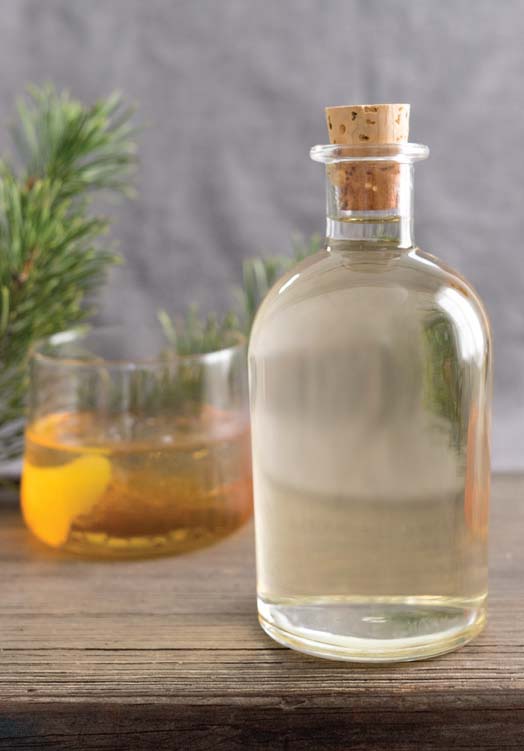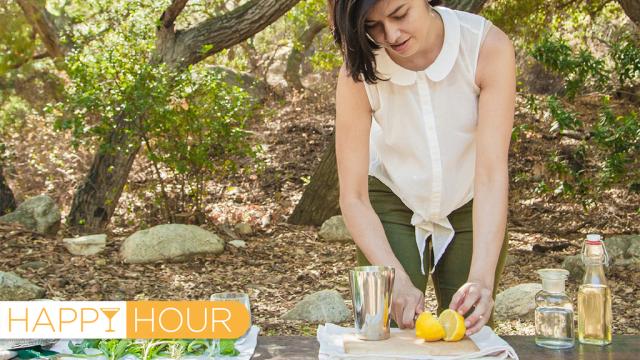I was traipsing around a conifer forest, looking for the perfect white fir. I wasn’t hunting for a Christmas tree. I had just been taught to see the wilderness as my own personal liquor cabinet, and I was searching for ingredients for my next cocktail.
Under the guidance of my friend and foraging expert Emily Han, I made a citrusy pine syrup that eventually stirred its way into a perfectly festive old-fashioned. It’s one of many delicious recipes in her book, Wild Drinks & Cocktails: Handcrafted Squashes, Shrubs, Switchels, Tonics, and Infusions to Mix at Home, which takes the idea of hand-crafted, local mixology to another level.
Sourcing your old-fashioned from a nearby forest might seem like a lot of work, but slipping a little nature into your cocktail shaker makes for a great seasonal twist using what are guaranteed to be ultra-fresh ingredients. It’s also a great introduction to foraging for those who aren’t quite ready to dive head first into a plate of dandelion greens, notes Han. “Not everyone wants to eat a handful of ‘weeds’ you foraged, but they can get on board with a cocktail or soda!”
Han began her own foraging lifestyle as an avid hiker in her Los Angeles neighbourhood. “I became curious about the plants I encountered, and as a food lover and recipe developer, I was even more excited when I learned some of them were edible — or when I’d come across something clearly edible, like overhanging grapefruits or feral peach trees!” (The rule adhered to by most foragers is that if the fruit hangs over a fence into public space like a footpath, it’s fair game; a “feral” tree might have been planted in a park or as part of a former orchard.)
Over time, Han realised the act of identifying and gathering edibles in her neighbourhood taught her more about her home. “It gave me a sense of connection and rhythm in a place that people often believe doesn’t have seasons, or even nature.”
Han’s Instagram is a must-follow for inspiring recipes and details about upcoming foraging classes, if you live in LA
Although you’re probably familiar with the idea of foraging, there’s a new term surfacing among Han’s fellow gatherers: “wildcrafting” (although the words are still somewhat interchangeable). “Wildcrafting is the practice of gathering medicine or food from wild plants and it encompasses not just the act of harvesting, but ethical considerations so you’re caring for the plant and its ecosystem,” says Han.
Which is why her book also includes detailed instructions for how to pinch and snip ingredients without disturbing the plant or any of its inhabitants. The concern of over-harvesting is another reason cocktails are perhaps the most responsible way to use what edibles you discover, she says. “A handful of flowers or berries may be all you need to create a flavorful, aromatic drink.”
Wildcrafted cocktails actually have roots in traditional herbal medicine. Many of the “tonics” prescribed by healthcare professionals back in the day were actually just liqueurs and cordials with ingredients sourced in the wild. Han has incorporated this element into her book as well, and yes, you can even use some of the recipes to treat your hangover the next day, should you overindulge. Of course the best recipes bridge both worlds, like fire cider, which Han makes from turmeric, orange, lemon, and wild chile pequín foraged from her mother’s yard in Texas. It’s like a powerful master-cleanse juice on its own, but makes a fun hot toddy with tequila or mescal.

Han’s foraged pine syrup and an old-fashioned made with it, recipe below
In preparation for your first foraging adventure, Han recommends gearing up with a good basket or backpack, plus some reusable produce bags, and a sturdy Tupperware container for delicate finds. And while fingers are almost always the best tool for harvesting, Han brings professional-grade equipment. “I always carry a mini Leatherman with scissors in case of spontaneous forging, or Felco pruners when I’ve planned ahead.”
And speaking of planning ahead, you’ll want to take plenty of time to identify not only the plants you’ll be collecting, but how they fit into the local environment. Check with local garden groups and horticultural societies that might offer expeditions. The good news is, you probably won’t need to walk more than a few blocks to find something delicious, says Han. “You’ll feel more connected to the place where you live — that to me is the best thing about foraging.”
Han’s right — in a quick stroll down my street I was able to find everything from pepper berries to pomegranates to fennel pollen, right there for the taking. Prime foraging season is just kicking off in Australia, but and evergreens are eternal, so I asked Han to share her recipe for her old-fashioned using pine syrup. Once you try it, you won’t ever see a forest in the same way.
Rye and Pine Old-Fashioned
Just because a cocktail’s called an old-fashioned doesn’t mean you can’t experiment with it! This recipe replaces the standard sugar or simple syrup with Pine Syrup, which is a beautiful complement to robust rye whiskey. The result is a cocktail that’s spicy and aromatic.
- 15ml Pine Syrup (recipe follows)
- 2 dashes aromatic bitters
- 60ml rye whiskey
- Ice cubes
- Lemon or orange twist
Combine the Pine Syrup and aromatic bitters in an old-fashioned glass. Add the whiskey and stir. Fill the glass with ice and stir again. Garnish with a twist of lemon, and serve immediately. Makes one serving.
Pine Syrup
Ever nibbled on a pine needle, fir tip, or spruce leaf? Try it! Chances are you’ll be rewarded with lemon, orange, or other citrus flavours, and you’ll also be getting a healthy dose of vitamin C.
This recipe starts out as a strong tea — tasty and healing in itself — and ends with a syrup that you can use to perk up a glass of fizzy water, a mug of hot tea, or a cocktail. Plus, teas and syrups made from these conifers have decongestant and expectorant effects that can be helpful during the winter cold and flu season. This syrup works well with other conifers like spruce or fir. Flavours vary between seasons (and even individual plants), so nibble as you forage and pick what tastes and smells good to you.
- 1 cup (200g) sugar
- 1 small handful conifer tips or needles, roughly chopped 1 cup (235ml) boiling water
Place the conifer tips or needles in a heat-proof ceramic or glass container. Pour boiling water over and cover the container. Let steep for at least 30 minutes and up to 24 hours. Strain through a fine-mesh strainer into a saucepan; discard the solids. Add the sugar to the pan. Bring to a simmer over medium-low heat, stirring to dissolve the sugar. Simmer for another minute. Remove from the heat and let cool. Store in the refrigerator for up to 1 month. Makes about one cup.
Wildcrafting Tip: Harvest pine (Pinus spp.), fir (Abies spp.), or spruce (Picea spp.) needles from the new growth at the tips of branches. In spring, you can often pinch the tender, bright green tips with your fingers; later in the season, use pruning shears to clip a few inches off the ends. Move around, and make sure not to harvest too much from any single tree. Also, never cut the top of a tree: that can make it vulnerable to decay and disease.
Top photo by Oriana Koren; cocktail images by Emily Han
It’s time for Happy Hour, Gizmodo’s weekly booze column. A cocktail shaker full of innovation, science and alcohol.
